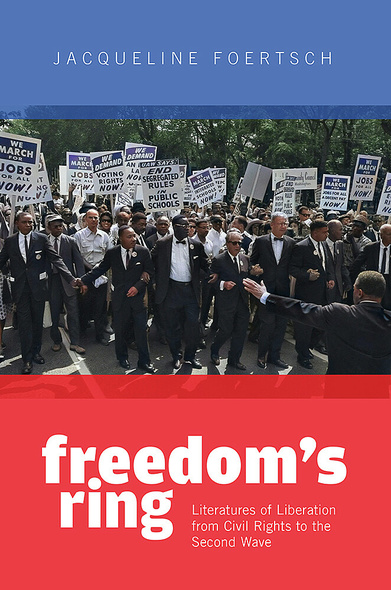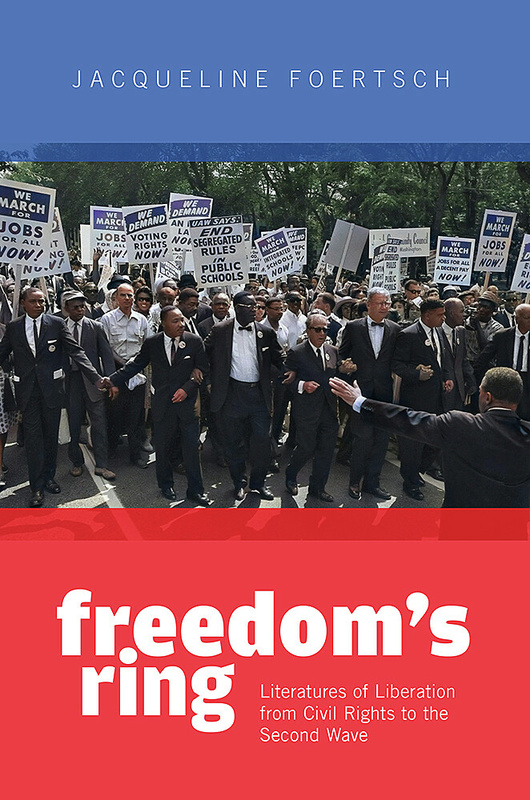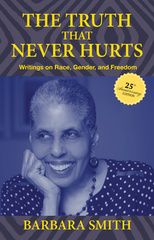
192 pages, 6 1/8 x 9 1/4
2 b-w images
Paperback
Release Date:16 Apr 2021
ISBN:9781978822719
Hardcover
Release Date:16 Apr 2021
ISBN:9781978822726
Freedom’s Ring
Literatures of Liberation from Civil Rights to the Second Wave
Rutgers University Press
Freedom’s Ring begins with the question of how the American ideal of freedom, which so effectively defends a conservative agenda today, from globally exploitative free trade to anti-French “freedom fries” during the War in Iraq, once bolstered the progressive causes of Freedom Summer, the Free Speech Movement, and more militant Black Power and Women’s Liberation movements with equal efficacy. Focused as it is on the faring of freedom throughout the liberation era, this book also explores attempts made by rights movements to achieve the often competitive or cross-canceling American ideal of equality–economic, professional, and otherwise. Although many struggled and died for it in the civil rights era, freedoms such as the vote, integrated bus rides, and sex without consequences via the Pill, are ultimately free–costing officialdom little if anything to fully implement—while equality with respect to jobs, salaries, education, housing, and health care, will forever be the much more expensive nut to crack. Freedom’s Ring regards the politics of freedom, and politics in general, as a low-cost substitute for and engrossing distraction from substantive economic problem-solving from the liberation era to the present day.
Hard fought, hardly equitable, and deeply contested, freedom remains a core concept in modern American national identity. Jacqueline Foertsch’s lively and compelling Freedom’s Ring traces how it rallied postwar Americans to fight for racial equality, personal liberation, and women’s rights from the 1950s to the 1970s with profound results.'
Jacqueline Foertsch’s Freedom’s Ring is a smart-minded and provocative inquiry into the literary legacy of the postwar Civil Rights era, the storied epoch from the 1950s to the 1970s that remains an inspiration to an ongoing struggle. Foertsch’s cultural criticism is authoritative and insightful, her voice captivating and passionate, and her subject timelier than ever.
The English professor explores the role of 'freedom' and 'equality' in literature of major rights-seeking movements from the 1960s and 1970s.
Hard fought, hardly equitable, and deeply contested, freedom remains a core concept in modern American national identity. Jacqueline Foertsch’s lively and compelling Freedom’s Ring traces how it rallied postwar Americans to fight for racial equality, personal liberation, and women’s rights from the 1950s to the 1970s with profound results.'
Jacqueline Foertsch’s Freedom’s Ring is a smart-minded and provocative inquiry into the literary legacy of the postwar Civil Rights era, the storied epoch from the 1950s to the 1970s that remains an inspiration to an ongoing struggle. Foertsch’s cultural criticism is authoritative and insightful, her voice captivating and passionate, and her subject timelier than ever.
The English professor explores the role of 'freedom' and 'equality' in literature of major rights-seeking movements from the 1960s and 1970s.
JACQUELINE FOERTSCH is a professor of English and chair of the steering committee for Postwar Faculty Colloquium at the University of North Texas in Denton. She is the author of several books including American Drama: In Dialogue, 1714-Present and Reckoning Day: Race, Place, and the Atom Bomb in Postwar America.
Introduction: Freedom’s Ring throughout the Post-WWII Decades
1 Talking First and Shooting Later in the Black Power Era
2 Nothing Left to Lose: Maximizing Liberties in the Late 1960s Free-for-All
3 Tools of the Trade: Working Women and Radical Women in the Liberation Era
Conclusion: Postscript from the Present Day
Acknowledgments
Notes
Works Cited
Index
1 Talking First and Shooting Later in the Black Power Era
2 Nothing Left to Lose: Maximizing Liberties in the Late 1960s Free-for-All
3 Tools of the Trade: Working Women and Radical Women in the Liberation Era
Conclusion: Postscript from the Present Day
Acknowledgments
Notes
Works Cited
Index






